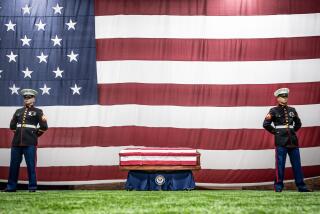Marines Update Casualty Plan
In anticipation of casualties as U.S. Marines return to Iraq this month, Marine Corps officials have streamlined their process for notifying the families of troops who are killed or injured.
Lt. Gen. James T. Conway, commander of the Camp Pendleton-based 1st Marine Expeditionary Force, said the method for providing information to families was too slow and “fractured” during the invasion of Iraq that began nearly a year ago.
In some cases, families received few details about the cause of the death. In other cases, officers were able to notify families only moments before the news began to circulate publicly. Sixty-five Marines had been killed by May 1, 2003, when President Bush declared an end to the major combat phase of the war.
An updated computer software program will send information from the field to the Marine’s home base before the news is released to reporters in Baghdad or at the Pentagon.
Marines involved in the notification system have been put on notice that Marine commanders want family members informed and assisted quickly.
About 25,000 Marines are set to relieve the Army’s 82nd Airborne Division in the so-called Sunni Triangle area north and west of Baghdad that has been a hotbed of anti-U.S. violence. The official transfer of authority is scheduled for this month.
Marine Corps policy -- similar to that of other services -- calls for families to be notified in person by an officer in dress uniform, accompanied by other Marines, a chaplain and possibly a medical specialist.
Some family members want the officers to spend time with them; others prefer to grieve in private.
This week, within hours of Pfc. Matthew G. Milczark, 18, being found dead of a “noncombat” gunshot wound in Kuwait, his family in Kettle River, Minn., received an unannounced visit by a Marine officer and a chaplain from Duluth with the bad news.
“They offered to stay as long as we needed them,” said Linda Milczark, the Marine’s stepmother. “It helped a lot. They promised us they’ll do anything we need.”
The new software is also meant to help families receive updated information when a loved one is injured, including where he or she is being treated. Information is provided to the home bases so families can be kept informed.
“Once they were sent into the medical pipeline, we didn’t have much contact with them,” said Bryan Driver, spokesman for the personal and family readiness division at Marine Corps headquarters. “Now that won’t happen.”
The Army has a similar system for providing information about fatalities and injuries, said Shari Lawrence, a spokeswoman for the Army’s Human Resources Command in Alexandria, Va. The Army also gives families a phone number for updated information.
“Every soldier has a mother, and every mother has my phone number,” Lawrence said.
The prevalence of around-the-clock news and reporters with satellite phones has made the military’s task more difficult. Casualty notification officers talk of “the rush to the door” to beat reporters and others from reaching families before official notification can be made.
Last year, the task was made more difficult because troops were moving rapidly toward Baghdad and information about casualties sometimes was not quickly relayed.
For example, Capt. Kevin Hyde, a spokesman for the Marine base at Yuma, Ariz., remembers the opening hours of the invasion of Iraq when a CH-46E Sea Knight helicopter crashed in Kuwait, killing four Marines, including copilot Capt. Thomas Aubin, stationed at Yuma.
“We got to the door first, but it was close,” Hyde said.
More to Read
Sign up for Essential California
The most important California stories and recommendations in your inbox every morning.
You may occasionally receive promotional content from the Los Angeles Times.










